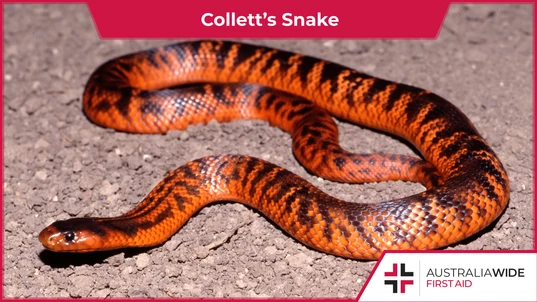First Aid for Collett's Snake

Bites and Stings

Distributed in parts of western and central Queensland, Collett's Snake has highly toxic venom that can cause abdominal pain, muscle necrosis, and even renal failure.
Collett's snake is renowned for a handful of reasons. Not only is it one of Australia's most elusive snake species, it is also arguably our most vibrantly coloured one. They are commonly misidentified as Tiger snakes, and though they are not closely related, both species have incredibly toxic venom that can destroy living cells. Continue reading for more information on Collett's snake (Pseudechis colletti) and what to do if you are bitten by one. We also cover snake bites in our following first aid courses: To find a first aid course near you, simply head to our Locations page and follow the prompts.Appearance
Collett's snake has a a broad, blunt head that is near indistinct from its robust, strongly built body. The scales on its top and sides are dark brown to black and covered in reddish to salmon-pink patches that form an irregular banded pattern. The scales on its underside tend to range from yellow-orange to cream, while its head is uniformly dark, though sometimes with a paler snout. Like the Blue belly black snake, Collett's snake generally has a total length of 1.5 metres and midbody scales 19 rows.Habitat
Collett's snake is generally found in drier areas of central to western Queensland. In these areas, they tend to inhabit:- Open grasslands
- Open woodlands
- Black soil plains, where they shelter in deep soil cracks, sinkholes, and under fallen timber
Habits
Though Collett's snake is active during the day and on warm evenings, they are secretive and rarely seen. In fact, their Conservation status is listed as 'Rare' in Queensland. Their preferred prey include:- Mammals
- Lizards
- Snakes
- Frogs
Danger to Humans
Collett's snake is considered a dangerously venomous snake. However, it is important to remember that they are a relatively placid species and will only adopt a defensive display when threatened. In the face of danger, they will firstly raise and inflate their forebody in a low curve and emit loud, short hisses until they tire and back away. If this does not dissuade the offender, they will then strike out and attempt to bite. The venom itself is highly dangerous, as it contains proteins that can cause muscle necrosis and damage to heart cells.Symptoms
According to the National Center for Biotechnology Information, initial symptoms of a Collett's snake bite can include:- Nausea and vomiting
- Abdominal pain and diarrhoea
- Headache
- Rhabdomyolysis, a serious medical condition in which muscle tissue dies and releases its contents into the bloodstream
- Acute renal failure, due to the release of muscle breakdown products into the bloodstream
First aid
If you are bitten by Collett's snake, contact Triple Zero (000) for medical attention and apply the Pressure Immobilisation Technique, as described in our Snake Bite Identify and Treat article. It is worthwhile noting, many snake species can vary in colour, pattern, and size, and so all snake bites should be considered a medical emergency.Final thoughts
Distributed in parts of central and western Queensland, Collett's snake is a reddish brown member of the Pseudechis genus that is considered dangerously venomous. Their venom can breakdown muscle tissue and cause acute renal failure. As such, if you are bitten by Collett s snake, or any one of the 200 known Australian snake species described by the Australian Museum, you should seek medical attention and apply the Pressure Immobilisation Technique. You can learn even more about identifying and treating snake bites in our following first aid courses: We offer these first aid courses in a variety of locations across central and western Queensland, including: To find a first aid course near you, simply to head our Locations page and follow the prompts.
Originally published at
https://www.australiawidefirstaid.com.au/resources/colletts-snake
as part of the Australia Wide First Aid Articles Library









